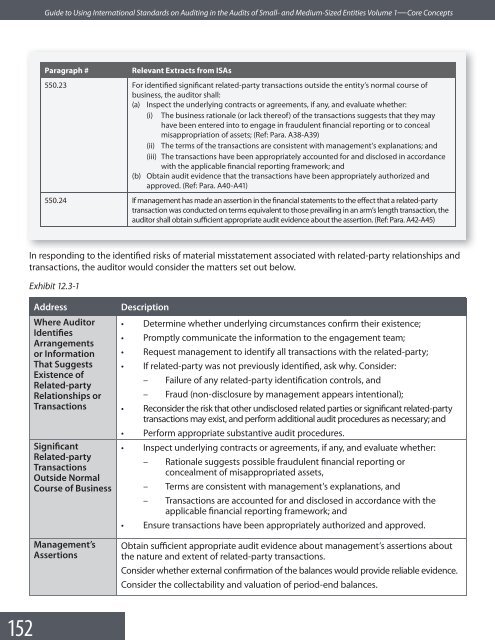Guide to Using International Standards on Auditing in - IFAC
Guide to Using International Standards on Auditing in - IFAC Guide to Using International Standards on Auditing in - IFAC
152
153
- Page 101 and 102: 101 Guide
- Page 103 and 104: 103 Guide
- Page 105 and 106: 105 Guide
- Page 107 and 108: 107 Guide
- Page 109 and 110: 109 Guide
- Page 111 and 112: 111 Guide
- Page 113 and 114: 113 Guide
- Page 115 and 116: 115 10. Further Audit Procedures Ch
- Page 117 and 118: 117 Guide
- Page 119 and 120: 119 Guide
- Page 121 and 122: 121 Guide
- Page 123 and 124: 123 Guide
- Page 125 and 126: 125 Guide
- Page 127 and 128: 127 Guide
- Page 129 and 130: 129 Guide
- Page 131 and 132: 131 Guide
- Page 133 and 134: 133 Guide
- Page 135 and 136: 135 Guide
- Page 137 and 138: 137 Guide
- Page 139 and 140: 139 Guide
- Page 141 and 142: 141 Guide
- Page 143 and 144: 143 Guide
- Page 145 and 146: 145 12. Related Parties Chapter Con
- Page 147 and 148: 147 Guide
- Page 149 and 150: 149 Guide
- Page 151: 151 Guide
- Page 155 and 156: 155 Guide
- Page 157 and 158: 157 Guide
- Page 159 and 160: 159 Guide
- Page 161 and 162: 161 14. Going Concern Chapter Conte
- Page 163 and 164: 163 Guide
- Page 165 and 166: 165 Guide
- Page 167 and 168: 167 Guide
- Page 169 and 170: 169 Guide
- Page 171 and 172: 171 15. Summary of Other ISA Requir
- Page 173 and 174: 173 Guide
- Page 175 and 176: 175 Guide
- Page 177 and 178: 177 Guide
- Page 179 and 180: 179 Guide
- Page 181 and 182: 181 Guide
- Page 183 and 184: 183 Guide
- Page 185 and 186: 185 Guide
- Page 187 and 188: 187 Guide
- Page 189 and 190: 189 Guide
- Page 191 and 192: 191 Guide
- Page 193 and 194: 193 Guide
- Page 195 and 196: 195 Guide
- Page 197 and 198: 197 Guide
- Page 199 and 200: 199 Guide
- Page 201 and 202: 201 Guide
152<br />
<str<strong>on</strong>g>Guide</str<strong>on</strong>g> <str<strong>on</strong>g>to</str<strong>on</strong>g> <str<strong>on</strong>g>Us<strong>in</strong>g</str<strong>on</strong>g> <str<strong>on</strong>g>Internati<strong>on</strong>al</str<strong>on</strong>g> <str<strong>on</strong>g>Standards</str<strong>on</strong>g> <strong>on</strong> <strong>Audit<strong>in</strong>g</strong> <strong>in</strong> the Audits of Small- and Medium-Sized Entities Volume 1—Core C<strong>on</strong>cepts<br />
Paragraph #<br />
Relevant Extracts from ISAs<br />
550.23 For identified significant related-party transacti<strong>on</strong>s outside the entity’s normal course of<br />
bus<strong>in</strong>ess, the audi<str<strong>on</strong>g>to</str<strong>on</strong>g>r shall:<br />
(a) Inspect the underly<strong>in</strong>g c<strong>on</strong>tracts or agreements, if any, and evaluate whether:<br />
(i) The bus<strong>in</strong>ess rati<strong>on</strong>ale (or lack thereof) of the transacti<strong>on</strong>s suggests that they may<br />
have been entered <strong>in</strong><str<strong>on</strong>g>to</str<strong>on</strong>g> <str<strong>on</strong>g>to</str<strong>on</strong>g> engage <strong>in</strong> fraudulent f<strong>in</strong>ancial report<strong>in</strong>g or <str<strong>on</strong>g>to</str<strong>on</strong>g> c<strong>on</strong>ceal<br />
misappropriati<strong>on</strong> of assets; (Ref: Para. A38-A39)<br />
(ii) The terms of the transacti<strong>on</strong>s are c<strong>on</strong>sistent with management’s explanati<strong>on</strong>s; and<br />
(iii) The transacti<strong>on</strong>s have been appropriately accounted for and disclosed <strong>in</strong> accordance<br />
with the applicable f<strong>in</strong>ancial report<strong>in</strong>g framework; and<br />
(b) Obta<strong>in</strong> audit evidence that the transacti<strong>on</strong>s have been appropriately authorized and<br />
approved. (Ref: Para. A40-A41)<br />
550.24 If management has made an asserti<strong>on</strong> <strong>in</strong> the f<strong>in</strong>ancial statements <str<strong>on</strong>g>to</str<strong>on</strong>g> the effect that a related-party<br />
transacti<strong>on</strong> was c<strong>on</strong>ducted <strong>on</strong> terms equivalent <str<strong>on</strong>g>to</str<strong>on</strong>g> those prevail<strong>in</strong>g <strong>in</strong> an arm’s length transacti<strong>on</strong>, the<br />
audi<str<strong>on</strong>g>to</str<strong>on</strong>g>r shall obta<strong>in</strong> sufficient appropriate audit evidence about the asserti<strong>on</strong>. (Ref: Para. A42-A45)<br />
In resp<strong>on</strong>d<strong>in</strong>g <str<strong>on</strong>g>to</str<strong>on</strong>g> the identified risks of material misstatement associated with related-party relati<strong>on</strong>ships and<br />
transacti<strong>on</strong>s, the audi<str<strong>on</strong>g>to</str<strong>on</strong>g>r would c<strong>on</strong>sider the matters set out below.<br />
Exhibit 12.3-1<br />
Address<br />
Where Audi<str<strong>on</strong>g>to</str<strong>on</strong>g>r<br />
Identifies<br />
Arrangements<br />
or Informati<strong>on</strong><br />
That Suggests<br />
Existence of<br />
Related-party<br />
Relati<strong>on</strong>ships or<br />
Transacti<strong>on</strong>s<br />
Significant<br />
Related-party<br />
Transacti<strong>on</strong>s<br />
Outside Normal<br />
Course of Bus<strong>in</strong>ess<br />
Management’s<br />
Asserti<strong>on</strong>s<br />
Descripti<strong>on</strong><br />
• Determ<strong>in</strong>e whether underly<strong>in</strong>g circumstances c<strong>on</strong>firm their existence;<br />
• Promptly communicate the <strong>in</strong>formati<strong>on</strong> <str<strong>on</strong>g>to</str<strong>on</strong>g> the engagement team;<br />
• Request management <str<strong>on</strong>g>to</str<strong>on</strong>g> identify all transacti<strong>on</strong>s with the related-party;<br />
• If related-party was not previously identified, ask why. C<strong>on</strong>sider:<br />
– Failure of any related-party identificati<strong>on</strong> c<strong>on</strong>trols, and<br />
– Fraud (n<strong>on</strong>-disclosure by management appears <strong>in</strong>tenti<strong>on</strong>al);<br />
• Rec<strong>on</strong>sider the risk that other undisclosed related parties or significant related-party<br />
transacti<strong>on</strong>s may exist, and perform additi<strong>on</strong>al audit procedures as necessary; and<br />
• Perform appropriate substantive audit procedures.<br />
• Inspect underly<strong>in</strong>g c<strong>on</strong>tracts or agreements, if any, and evaluate whether:<br />
– Rati<strong>on</strong>ale suggests possible fraudulent f<strong>in</strong>ancial report<strong>in</strong>g or<br />
c<strong>on</strong>cealment of misappropriated assets,<br />
– Terms are c<strong>on</strong>sistent with management’s explanati<strong>on</strong>s, and<br />
– Transacti<strong>on</strong>s are accounted for and disclosed <strong>in</strong> accordance with the<br />
applicable f<strong>in</strong>ancial report<strong>in</strong>g framework; and<br />
• Ensure transacti<strong>on</strong>s have been appropriately authorized and approved.<br />
Obta<strong>in</strong> sufficient appropriate audit evidence about management’s asserti<strong>on</strong>s about<br />
the nature and extent of related-party transacti<strong>on</strong>s.<br />
C<strong>on</strong>sider whether external c<strong>on</strong>firmati<strong>on</strong> of the balances would provide reliable evidence.<br />
C<strong>on</strong>sider the collectability and valuati<strong>on</strong> of period-end balances.



